What is a Rent Increase Letter?
A Rent Increase Letter is a formal notification sent by a landlord to a tenant, informing them of an upcoming increase in rent. This document outlines the details of the rent adjustment, such as the new rent amount, the date the increase will take effect, and the reasons for the increase. It serves as a legal requirement to ensure tenants are properly notified within a specified time frame before the new rent takes effect.
Why do I need to use a Rent Increase Letter?
Using a Rent Increase Letter is crucial for maintaining clear communication between landlords and tenants regarding changes in the rental agreement, specifically rent adjustments. It serves as official documentation of the landlord's intent to increase the rent, helping to avoid misunderstandings or disputes. Furthermore, it ensures compliance with local and state regulations that govern rental increases, protecting both parties' rights.
When should a Rent Increase Letter be sent to a tenant?
The timing for sending a Rent Increase Letter varies depending on local and state laws. Generally, landlords are required to provide tenants with a notice period of 30 to 60 days before the rent increase takes effect. This time frame allows tenants to decide whether to agree to the new rent amount and continue the lease or to look for alternative housing options. It's essential to consult your specific state laws to adhere to the correct notice period.
What information should be included in a Rent Increase Letter?
A Rent Increase Letter should include the date the letter is sent, the tenant's name and address, the current rent amount, the new rent amount, the date the new rent will take effect, and a statement explaining the reason(s) for the rent increase. Additionally, it is advisable to include a reference to the section of the lease agreement that allows for rent adjustments, any required legal disclosures, and a contact number or email for the tenant to ask questions or discuss the increase.
Is there a standard format for a Rent Increase Letter?
While there is no single standard format for a Rent Increase Letter, it should be written in a clear and professional manner. It typically starts with a salutation to the tenant, followed by the body of the letter containing the necessary details of the rent increase, and concludes with a courteous closing and the landlord's signature. Ensuring the letter is easy to read and understand can help maintain a positive landlord-tenant relationship.
Can a tenant refuse the rent increase?
Tenants have the right to negotiate or contest a rent increase if they believe it is unfair or if it violates local rent control laws. If an agreement cannot be reached, the tenant may decide to terminate their lease according to the terms provided in the original rental agreement and applicable laws. It's important for tenants to communicate their concerns to the landlord in writing and seek legal advice if necessary.
How can I ensure my Rent Increase Letter complies with local laws?
To ensure compliance with local laws, it is advisable to research and understand the regulations governing rent increases in your area. This may include specific rules about how much notice must be given, the maximum allowable rent increase percentage, and any required legal disclosures. Consulting a legal professional or a local tenant's association can also provide valuable guidance and help avoid potential legal issues.
